Medication Administration Errors: Healthcare System Evaluation Report
VerifiedAdded on 2022/09/18
|10
|2704
|23
Report
AI Summary
This report provides a critical investigation of medication administration errors within the healthcare system, drawing evidence from primary research, professional guidelines and standards, and healthcare data. The report examines the causes of medication errors, including nurse activity, incorrect doses, and inadequate reporting, as identified through systematic reviews and direct observation studies. It analyzes the impact of these errors on patient outcomes, such as increased morbidity and mortality. The report also explores professional guidelines and standards, such as those from the National Patient Safety Agency and the WHO, which aim to reduce medication errors through standardized practices, training, and technological interventions. Furthermore, it presents healthcare data from the United Kingdom, highlighting the prevalence and economic burden of medication errors, and discusses the role of medical informatics in improving patient safety. The report concludes by emphasizing the need for immediate action, including medication reviews, effective education, and the implementation of computerized provider order entry systems to mitigate medication errors and enhance patient safety.
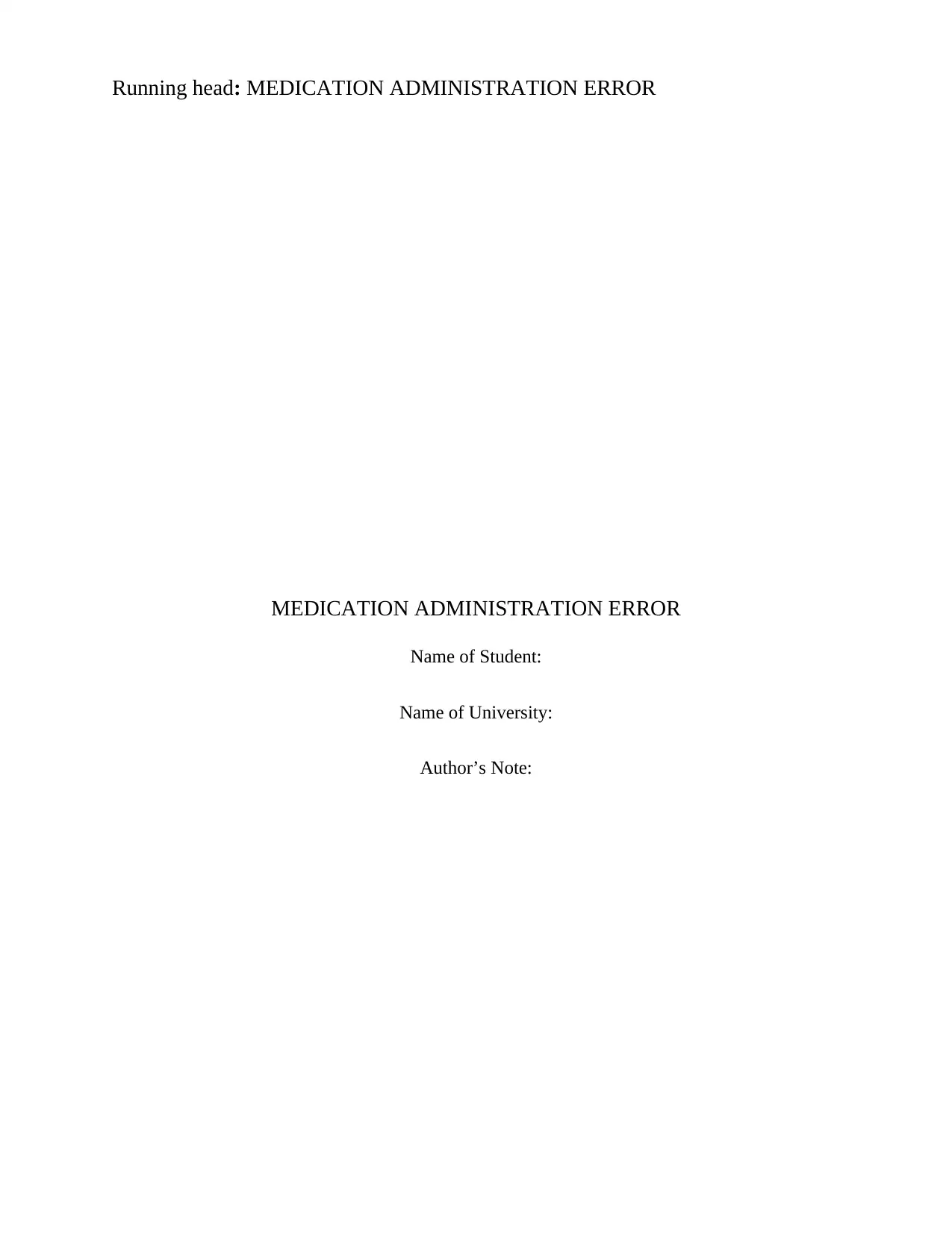
Running head: MEDICATION ADMINISTRATION ERROR
MEDICATION ADMINISTRATION ERROR
Name of Student:
Name of University:
Author’s Note:
MEDICATION ADMINISTRATION ERROR
Name of Student:
Name of University:
Author’s Note:
Paraphrase This Document
Need a fresh take? Get an instant paraphrase of this document with our AI Paraphraser
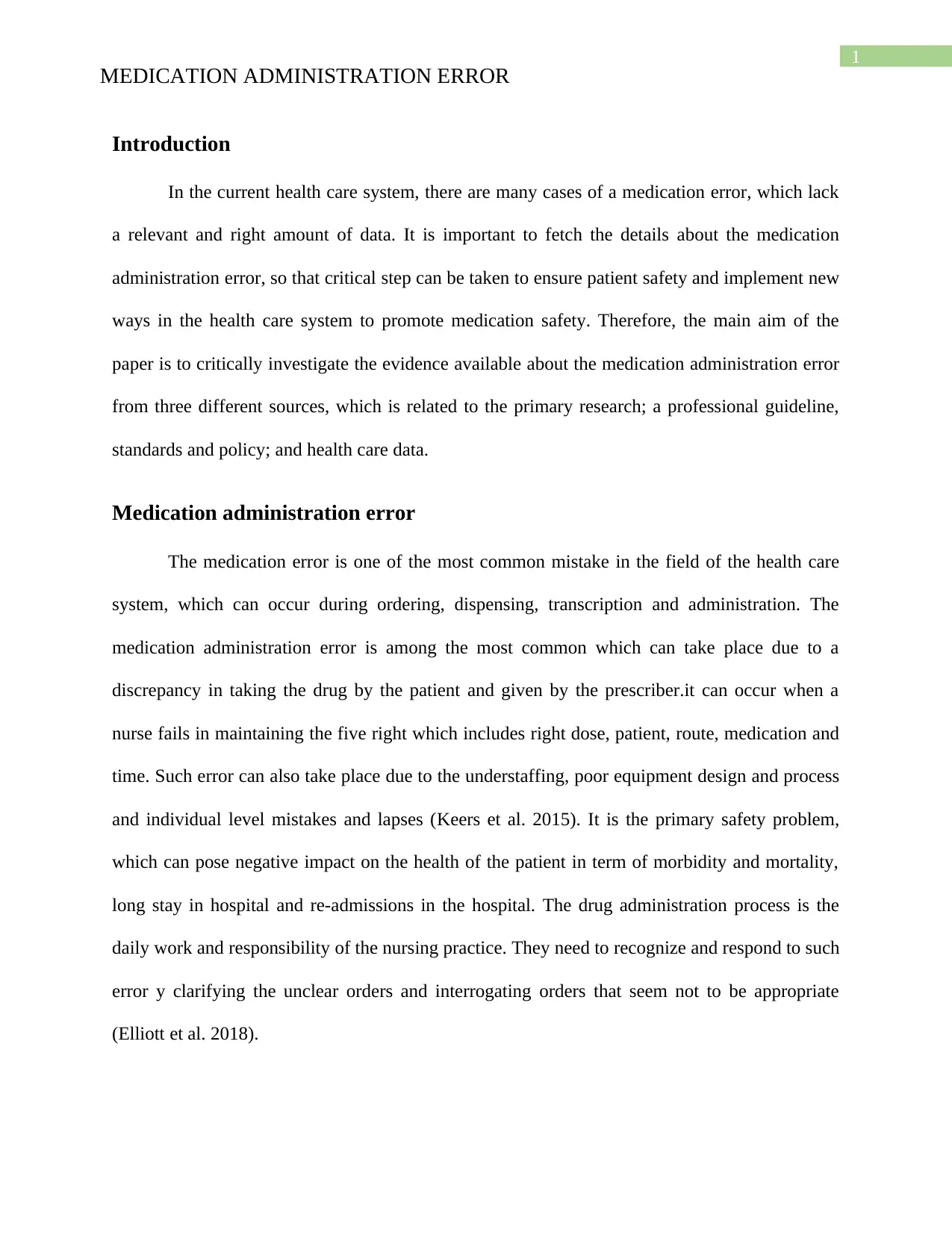
1
MEDICATION ADMINISTRATION ERROR
Introduction
In the current health care system, there are many cases of a medication error, which lack
a relevant and right amount of data. It is important to fetch the details about the medication
administration error, so that critical step can be taken to ensure patient safety and implement new
ways in the health care system to promote medication safety. Therefore, the main aim of the
paper is to critically investigate the evidence available about the medication administration error
from three different sources, which is related to the primary research; a professional guideline,
standards and policy; and health care data.
Medication administration error
The medication error is one of the most common mistake in the field of the health care
system, which can occur during ordering, dispensing, transcription and administration. The
medication administration error is among the most common which can take place due to a
discrepancy in taking the drug by the patient and given by the prescriber.it can occur when a
nurse fails in maintaining the five right which includes right dose, patient, route, medication and
time. Such error can also take place due to the understaffing, poor equipment design and process
and individual level mistakes and lapses (Keers et al. 2015). It is the primary safety problem,
which can pose negative impact on the health of the patient in term of morbidity and mortality,
long stay in hospital and re-admissions in the hospital. The drug administration process is the
daily work and responsibility of the nursing practice. They need to recognize and respond to such
error y clarifying the unclear orders and interrogating orders that seem not to be appropriate
(Elliott et al. 2018).
MEDICATION ADMINISTRATION ERROR
Introduction
In the current health care system, there are many cases of a medication error, which lack
a relevant and right amount of data. It is important to fetch the details about the medication
administration error, so that critical step can be taken to ensure patient safety and implement new
ways in the health care system to promote medication safety. Therefore, the main aim of the
paper is to critically investigate the evidence available about the medication administration error
from three different sources, which is related to the primary research; a professional guideline,
standards and policy; and health care data.
Medication administration error
The medication error is one of the most common mistake in the field of the health care
system, which can occur during ordering, dispensing, transcription and administration. The
medication administration error is among the most common which can take place due to a
discrepancy in taking the drug by the patient and given by the prescriber.it can occur when a
nurse fails in maintaining the five right which includes right dose, patient, route, medication and
time. Such error can also take place due to the understaffing, poor equipment design and process
and individual level mistakes and lapses (Keers et al. 2015). It is the primary safety problem,
which can pose negative impact on the health of the patient in term of morbidity and mortality,
long stay in hospital and re-admissions in the hospital. The drug administration process is the
daily work and responsibility of the nursing practice. They need to recognize and respond to such
error y clarifying the unclear orders and interrogating orders that seem not to be appropriate
(Elliott et al. 2018).
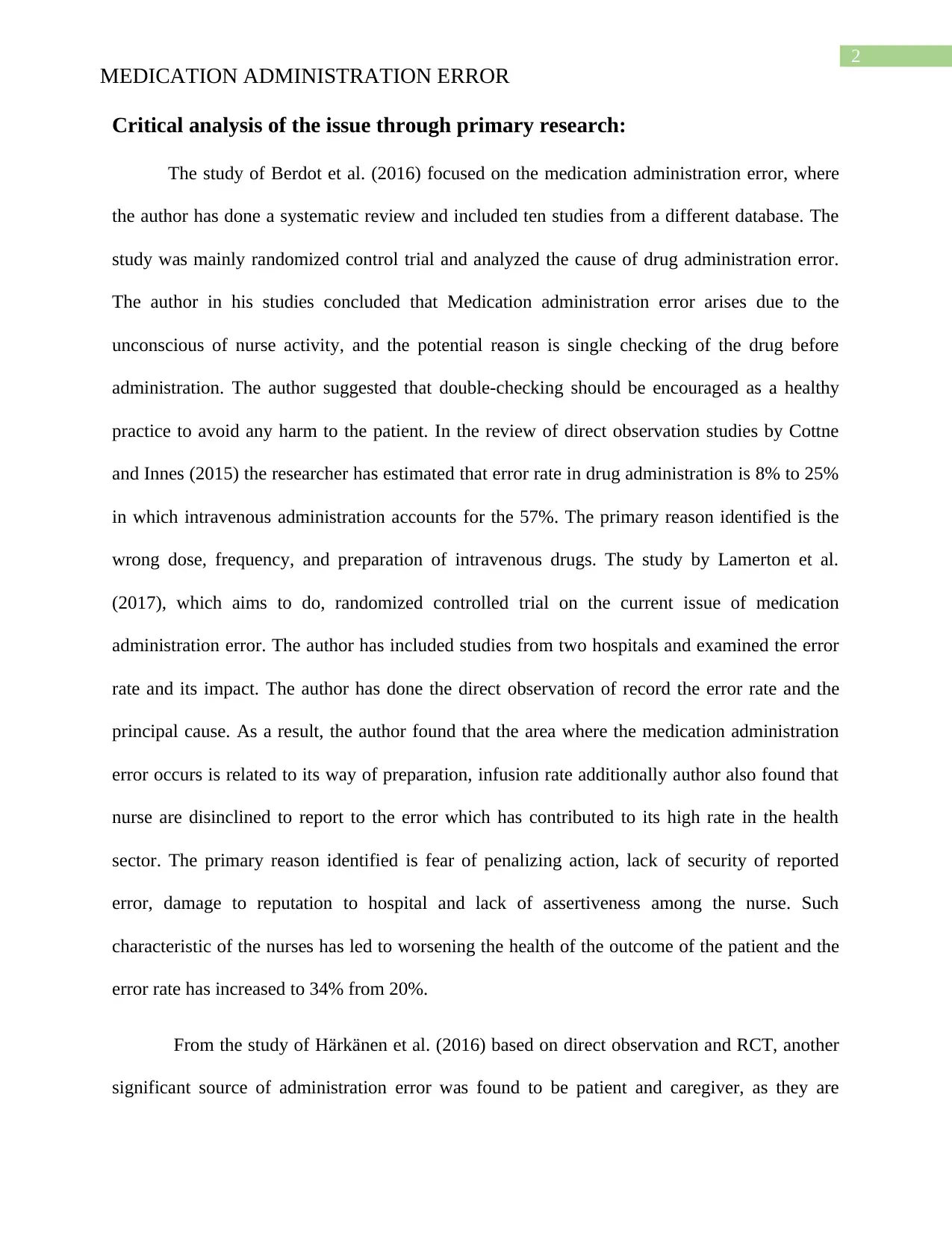
2
MEDICATION ADMINISTRATION ERROR
Critical analysis of the issue through primary research:
The study of Berdot et al. (2016) focused on the medication administration error, where
the author has done a systematic review and included ten studies from a different database. The
study was mainly randomized control trial and analyzed the cause of drug administration error.
The author in his studies concluded that Medication administration error arises due to the
unconscious of nurse activity, and the potential reason is single checking of the drug before
administration. The author suggested that double-checking should be encouraged as a healthy
practice to avoid any harm to the patient. In the review of direct observation studies by Cottne
and Innes (2015) the researcher has estimated that error rate in drug administration is 8% to 25%
in which intravenous administration accounts for the 57%. The primary reason identified is the
wrong dose, frequency, and preparation of intravenous drugs. The study by Lamerton et al.
(2017), which aims to do, randomized controlled trial on the current issue of medication
administration error. The author has included studies from two hospitals and examined the error
rate and its impact. The author has done the direct observation of record the error rate and the
principal cause. As a result, the author found that the area where the medication administration
error occurs is related to its way of preparation, infusion rate additionally author also found that
nurse are disinclined to report to the error which has contributed to its high rate in the health
sector. The primary reason identified is fear of penalizing action, lack of security of reported
error, damage to reputation to hospital and lack of assertiveness among the nurse. Such
characteristic of the nurses has led to worsening the health of the outcome of the patient and the
error rate has increased to 34% from 20%.
From the study of Härkänen et al. (2016) based on direct observation and RCT, another
significant source of administration error was found to be patient and caregiver, as they are
MEDICATION ADMINISTRATION ERROR
Critical analysis of the issue through primary research:
The study of Berdot et al. (2016) focused on the medication administration error, where
the author has done a systematic review and included ten studies from a different database. The
study was mainly randomized control trial and analyzed the cause of drug administration error.
The author in his studies concluded that Medication administration error arises due to the
unconscious of nurse activity, and the potential reason is single checking of the drug before
administration. The author suggested that double-checking should be encouraged as a healthy
practice to avoid any harm to the patient. In the review of direct observation studies by Cottne
and Innes (2015) the researcher has estimated that error rate in drug administration is 8% to 25%
in which intravenous administration accounts for the 57%. The primary reason identified is the
wrong dose, frequency, and preparation of intravenous drugs. The study by Lamerton et al.
(2017), which aims to do, randomized controlled trial on the current issue of medication
administration error. The author has included studies from two hospitals and examined the error
rate and its impact. The author has done the direct observation of record the error rate and the
principal cause. As a result, the author found that the area where the medication administration
error occurs is related to its way of preparation, infusion rate additionally author also found that
nurse are disinclined to report to the error which has contributed to its high rate in the health
sector. The primary reason identified is fear of penalizing action, lack of security of reported
error, damage to reputation to hospital and lack of assertiveness among the nurse. Such
characteristic of the nurses has led to worsening the health of the outcome of the patient and the
error rate has increased to 34% from 20%.
From the study of Härkänen et al. (2016) based on direct observation and RCT, another
significant source of administration error was found to be patient and caregiver, as they are
⊘ This is a preview!⊘
Do you want full access?
Subscribe today to unlock all pages.

Trusted by 1+ million students worldwide
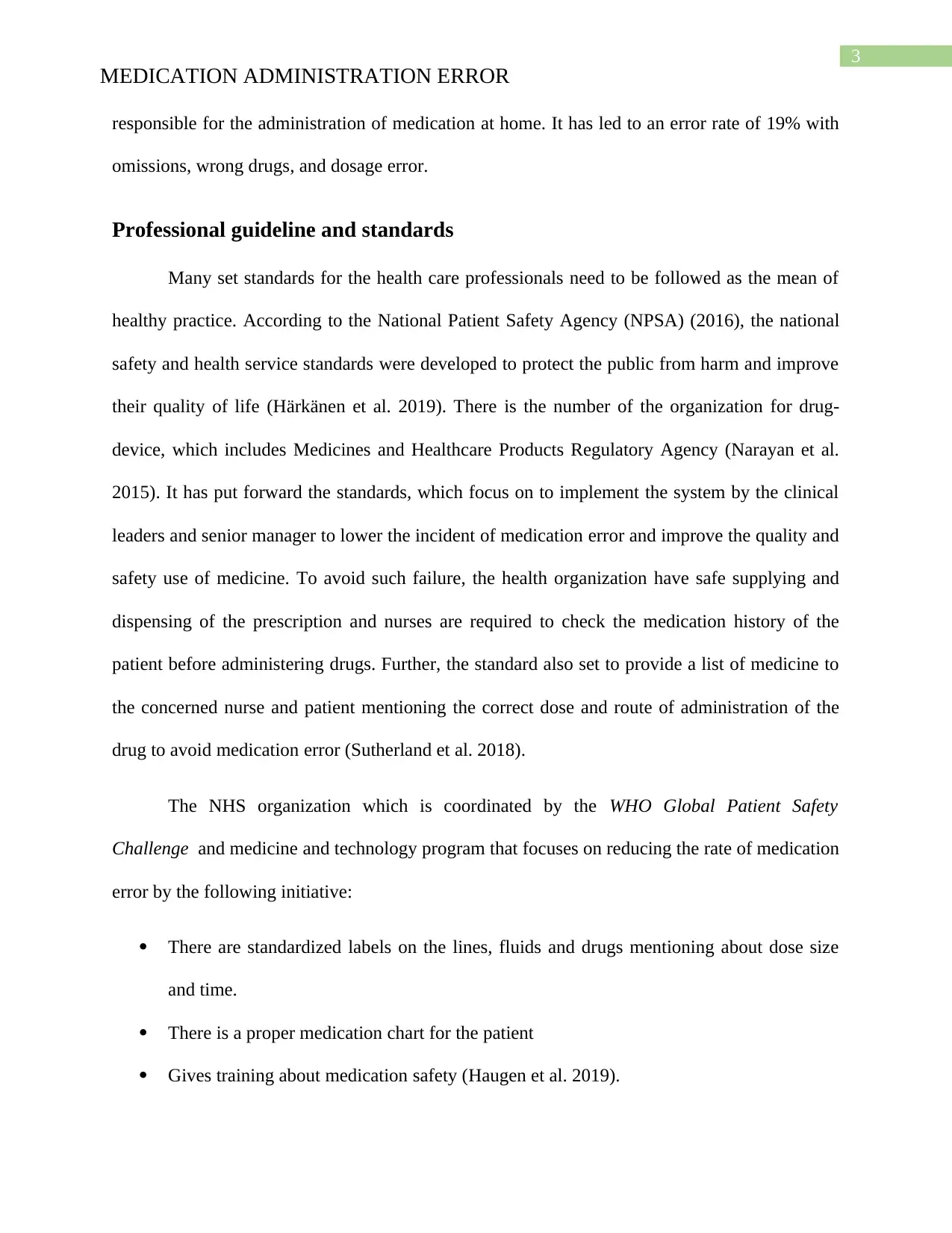
3
MEDICATION ADMINISTRATION ERROR
responsible for the administration of medication at home. It has led to an error rate of 19% with
omissions, wrong drugs, and dosage error.
Professional guideline and standards
Many set standards for the health care professionals need to be followed as the mean of
healthy practice. According to the National Patient Safety Agency (NPSA) (2016), the national
safety and health service standards were developed to protect the public from harm and improve
their quality of life (Härkänen et al. 2019). There is the number of the organization for drug-
device, which includes Medicines and Healthcare Products Regulatory Agency (Narayan et al.
2015). It has put forward the standards, which focus on to implement the system by the clinical
leaders and senior manager to lower the incident of medication error and improve the quality and
safety use of medicine. To avoid such failure, the health organization have safe supplying and
dispensing of the prescription and nurses are required to check the medication history of the
patient before administering drugs. Further, the standard also set to provide a list of medicine to
the concerned nurse and patient mentioning the correct dose and route of administration of the
drug to avoid medication error (Sutherland et al. 2018).
The NHS organization which is coordinated by the WHO Global Patient Safety
Challenge and medicine and technology program that focuses on reducing the rate of medication
error by the following initiative:
There are standardized labels on the lines, fluids and drugs mentioning about dose size
and time.
There is a proper medication chart for the patient
Gives training about medication safety (Haugen et al. 2019).
MEDICATION ADMINISTRATION ERROR
responsible for the administration of medication at home. It has led to an error rate of 19% with
omissions, wrong drugs, and dosage error.
Professional guideline and standards
Many set standards for the health care professionals need to be followed as the mean of
healthy practice. According to the National Patient Safety Agency (NPSA) (2016), the national
safety and health service standards were developed to protect the public from harm and improve
their quality of life (Härkänen et al. 2019). There is the number of the organization for drug-
device, which includes Medicines and Healthcare Products Regulatory Agency (Narayan et al.
2015). It has put forward the standards, which focus on to implement the system by the clinical
leaders and senior manager to lower the incident of medication error and improve the quality and
safety use of medicine. To avoid such failure, the health organization have safe supplying and
dispensing of the prescription and nurses are required to check the medication history of the
patient before administering drugs. Further, the standard also set to provide a list of medicine to
the concerned nurse and patient mentioning the correct dose and route of administration of the
drug to avoid medication error (Sutherland et al. 2018).
The NHS organization which is coordinated by the WHO Global Patient Safety
Challenge and medicine and technology program that focuses on reducing the rate of medication
error by the following initiative:
There are standardized labels on the lines, fluids and drugs mentioning about dose size
and time.
There is a proper medication chart for the patient
Gives training about medication safety (Haugen et al. 2019).
Paraphrase This Document
Need a fresh take? Get an instant paraphrase of this document with our AI Paraphraser
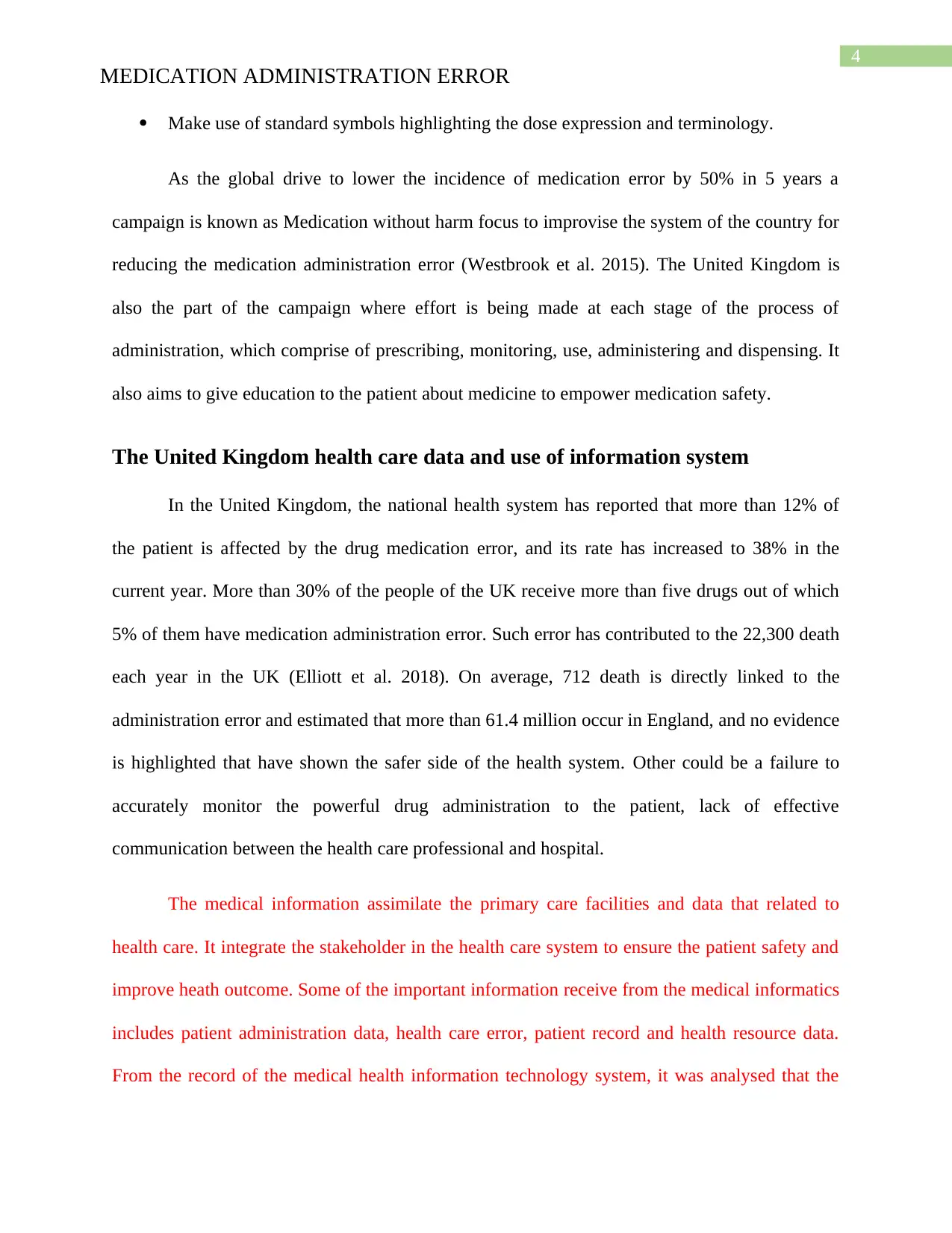
4
MEDICATION ADMINISTRATION ERROR
Make use of standard symbols highlighting the dose expression and terminology.
As the global drive to lower the incidence of medication error by 50% in 5 years a
campaign is known as Medication without harm focus to improvise the system of the country for
reducing the medication administration error (Westbrook et al. 2015). The United Kingdom is
also the part of the campaign where effort is being made at each stage of the process of
administration, which comprise of prescribing, monitoring, use, administering and dispensing. It
also aims to give education to the patient about medicine to empower medication safety.
The United Kingdom health care data and use of information system
In the United Kingdom, the national health system has reported that more than 12% of
the patient is affected by the drug medication error, and its rate has increased to 38% in the
current year. More than 30% of the people of the UK receive more than five drugs out of which
5% of them have medication administration error. Such error has contributed to the 22,300 death
each year in the UK (Elliott et al. 2018). On average, 712 death is directly linked to the
administration error and estimated that more than 61.4 million occur in England, and no evidence
is highlighted that have shown the safer side of the health system. Other could be a failure to
accurately monitor the powerful drug administration to the patient, lack of effective
communication between the health care professional and hospital.
The medical information assimilate the primary care facilities and data that related to
health care. It integrate the stakeholder in the health care system to ensure the patient safety and
improve heath outcome. Some of the important information receive from the medical informatics
includes patient administration data, health care error, patient record and health resource data.
From the record of the medical health information technology system, it was analysed that the
MEDICATION ADMINISTRATION ERROR
Make use of standard symbols highlighting the dose expression and terminology.
As the global drive to lower the incidence of medication error by 50% in 5 years a
campaign is known as Medication without harm focus to improvise the system of the country for
reducing the medication administration error (Westbrook et al. 2015). The United Kingdom is
also the part of the campaign where effort is being made at each stage of the process of
administration, which comprise of prescribing, monitoring, use, administering and dispensing. It
also aims to give education to the patient about medicine to empower medication safety.
The United Kingdom health care data and use of information system
In the United Kingdom, the national health system has reported that more than 12% of
the patient is affected by the drug medication error, and its rate has increased to 38% in the
current year. More than 30% of the people of the UK receive more than five drugs out of which
5% of them have medication administration error. Such error has contributed to the 22,300 death
each year in the UK (Elliott et al. 2018). On average, 712 death is directly linked to the
administration error and estimated that more than 61.4 million occur in England, and no evidence
is highlighted that have shown the safer side of the health system. Other could be a failure to
accurately monitor the powerful drug administration to the patient, lack of effective
communication between the health care professional and hospital.
The medical information assimilate the primary care facilities and data that related to
health care. It integrate the stakeholder in the health care system to ensure the patient safety and
improve heath outcome. Some of the important information receive from the medical informatics
includes patient administration data, health care error, patient record and health resource data.
From the record of the medical health information technology system, it was analysed that the
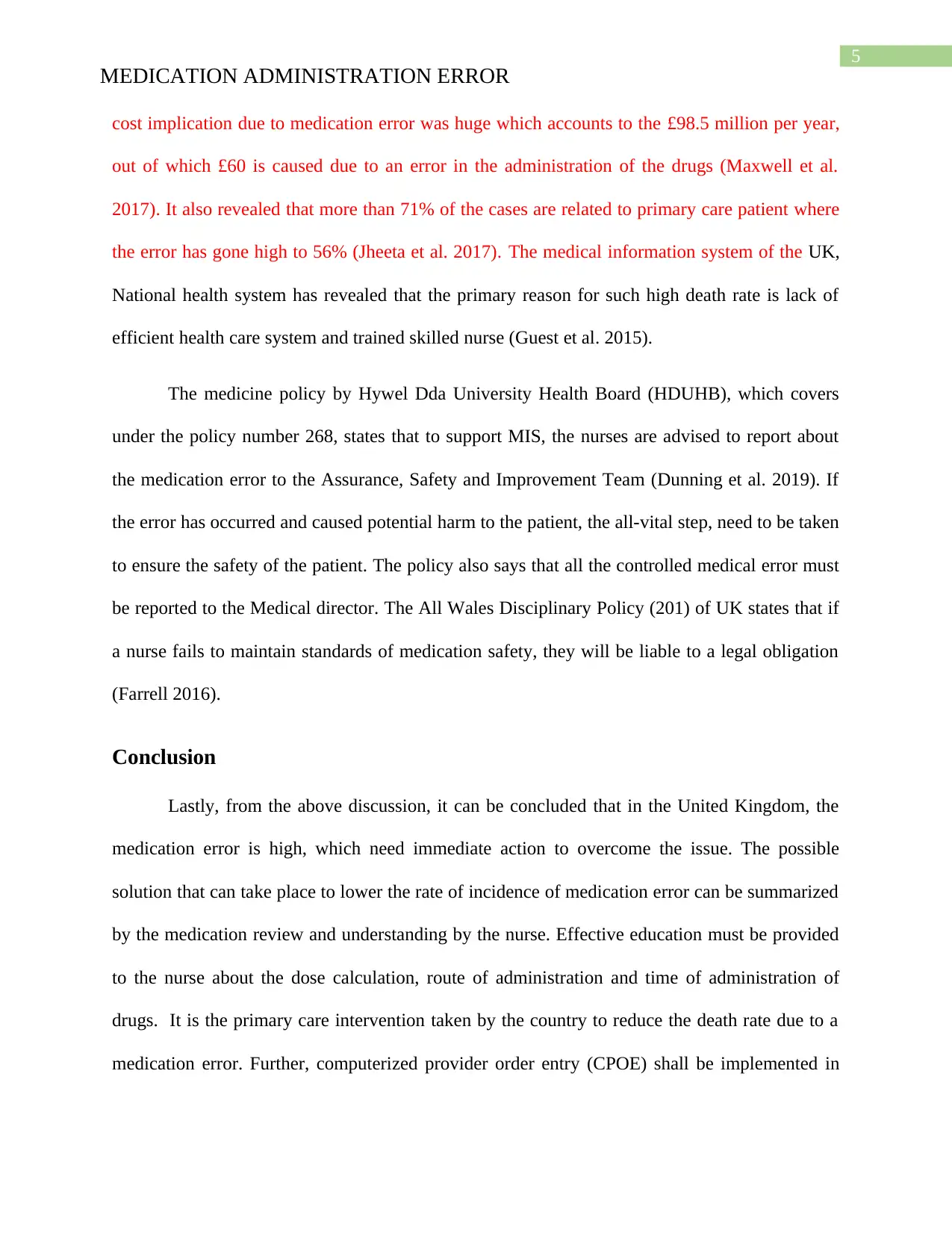
5
MEDICATION ADMINISTRATION ERROR
cost implication due to medication error was huge which accounts to the £98.5 million per year,
out of which £60 is caused due to an error in the administration of the drugs (Maxwell et al.
2017). It also revealed that more than 71% of the cases are related to primary care patient where
the error has gone high to 56% (Jheeta et al. 2017). The medical information system of the UK,
National health system has revealed that the primary reason for such high death rate is lack of
efficient health care system and trained skilled nurse (Guest et al. 2015).
The medicine policy by Hywel Dda University Health Board (HDUHB), which covers
under the policy number 268, states that to support MIS, the nurses are advised to report about
the medication error to the Assurance, Safety and Improvement Team (Dunning et al. 2019). If
the error has occurred and caused potential harm to the patient, the all-vital step, need to be taken
to ensure the safety of the patient. The policy also says that all the controlled medical error must
be reported to the Medical director. The All Wales Disciplinary Policy (201) of UK states that if
a nurse fails to maintain standards of medication safety, they will be liable to a legal obligation
(Farrell 2016).
Conclusion
Lastly, from the above discussion, it can be concluded that in the United Kingdom, the
medication error is high, which need immediate action to overcome the issue. The possible
solution that can take place to lower the rate of incidence of medication error can be summarized
by the medication review and understanding by the nurse. Effective education must be provided
to the nurse about the dose calculation, route of administration and time of administration of
drugs. It is the primary care intervention taken by the country to reduce the death rate due to a
medication error. Further, computerized provider order entry (CPOE) shall be implemented in
MEDICATION ADMINISTRATION ERROR
cost implication due to medication error was huge which accounts to the £98.5 million per year,
out of which £60 is caused due to an error in the administration of the drugs (Maxwell et al.
2017). It also revealed that more than 71% of the cases are related to primary care patient where
the error has gone high to 56% (Jheeta et al. 2017). The medical information system of the UK,
National health system has revealed that the primary reason for such high death rate is lack of
efficient health care system and trained skilled nurse (Guest et al. 2015).
The medicine policy by Hywel Dda University Health Board (HDUHB), which covers
under the policy number 268, states that to support MIS, the nurses are advised to report about
the medication error to the Assurance, Safety and Improvement Team (Dunning et al. 2019). If
the error has occurred and caused potential harm to the patient, the all-vital step, need to be taken
to ensure the safety of the patient. The policy also says that all the controlled medical error must
be reported to the Medical director. The All Wales Disciplinary Policy (201) of UK states that if
a nurse fails to maintain standards of medication safety, they will be liable to a legal obligation
(Farrell 2016).
Conclusion
Lastly, from the above discussion, it can be concluded that in the United Kingdom, the
medication error is high, which need immediate action to overcome the issue. The possible
solution that can take place to lower the rate of incidence of medication error can be summarized
by the medication review and understanding by the nurse. Effective education must be provided
to the nurse about the dose calculation, route of administration and time of administration of
drugs. It is the primary care intervention taken by the country to reduce the death rate due to a
medication error. Further, computerized provider order entry (CPOE) shall be implemented in
⊘ This is a preview!⊘
Do you want full access?
Subscribe today to unlock all pages.

Trusted by 1+ million students worldwide
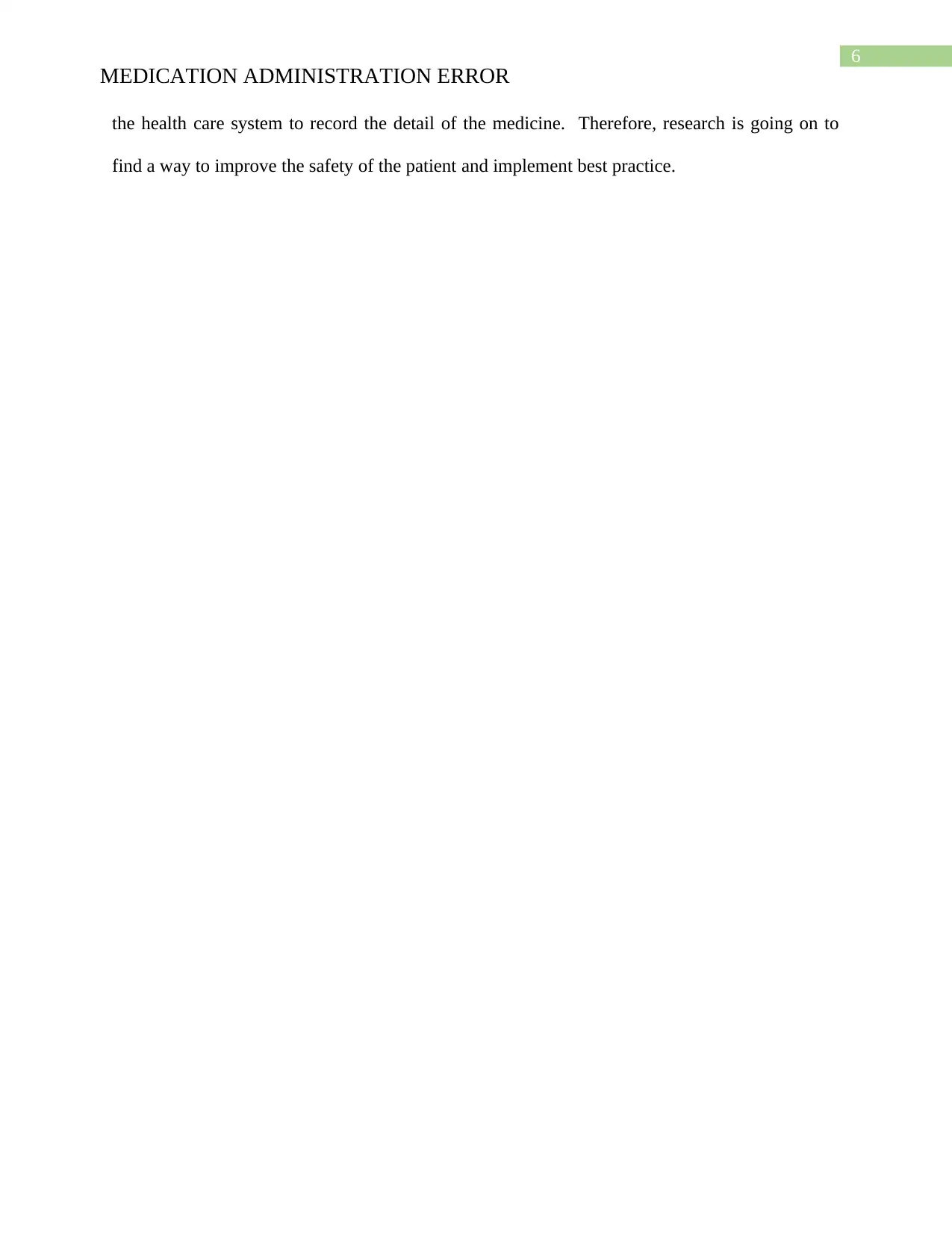
6
MEDICATION ADMINISTRATION ERROR
the health care system to record the detail of the medicine. Therefore, research is going on to
find a way to improve the safety of the patient and implement best practice.
MEDICATION ADMINISTRATION ERROR
the health care system to record the detail of the medicine. Therefore, research is going on to
find a way to improve the safety of the patient and implement best practice.
Paraphrase This Document
Need a fresh take? Get an instant paraphrase of this document with our AI Paraphraser
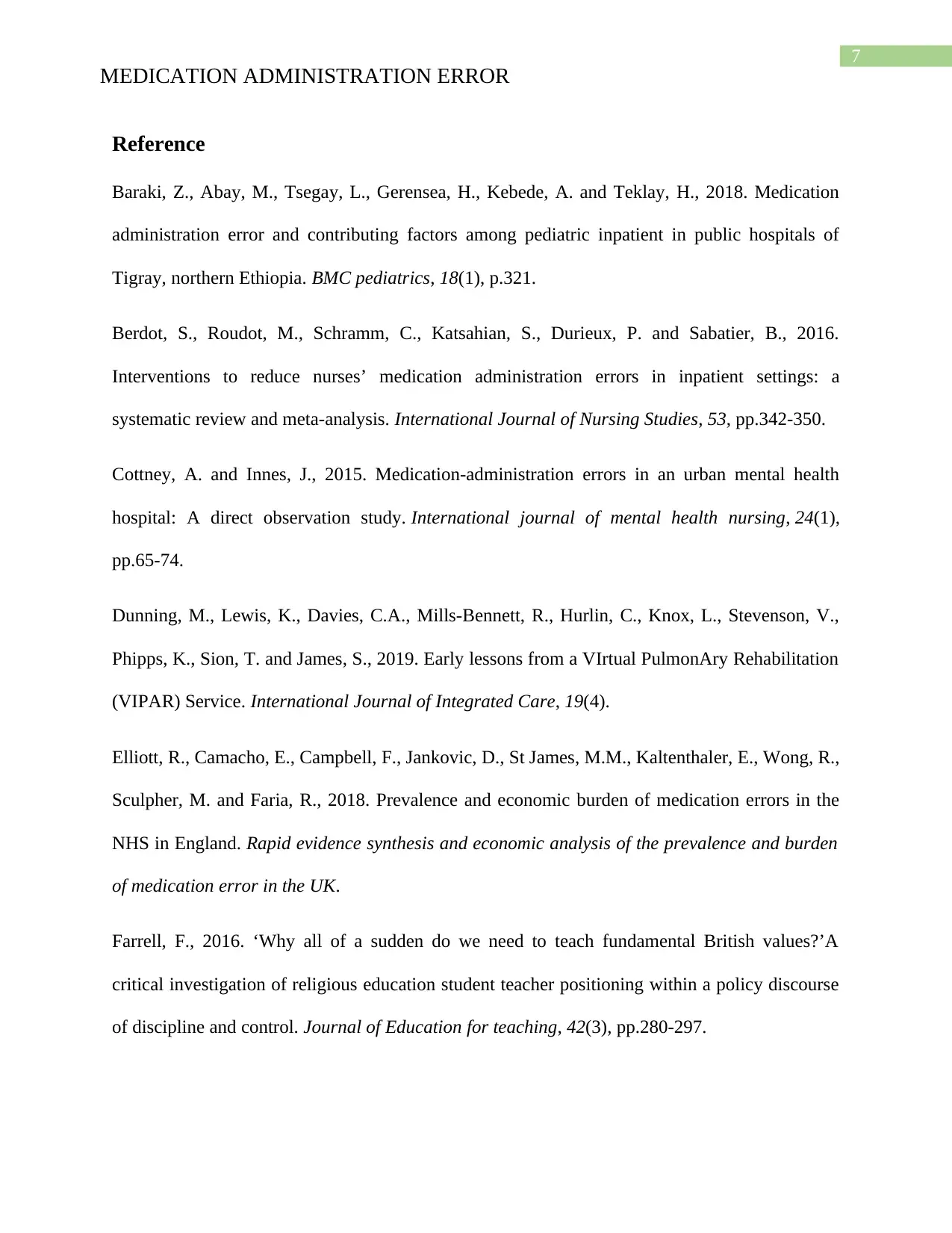
7
MEDICATION ADMINISTRATION ERROR
Reference
Baraki, Z., Abay, M., Tsegay, L., Gerensea, H., Kebede, A. and Teklay, H., 2018. Medication
administration error and contributing factors among pediatric inpatient in public hospitals of
Tigray, northern Ethiopia. BMC pediatrics, 18(1), p.321.
Berdot, S., Roudot, M., Schramm, C., Katsahian, S., Durieux, P. and Sabatier, B., 2016.
Interventions to reduce nurses’ medication administration errors in inpatient settings: a
systematic review and meta-analysis. International Journal of Nursing Studies, 53, pp.342-350.
Cottney, A. and Innes, J., 2015. Medication‐administration errors in an urban mental health
hospital: A direct observation study. International journal of mental health nursing, 24(1),
pp.65-74.
Dunning, M., Lewis, K., Davies, C.A., Mills-Bennett, R., Hurlin, C., Knox, L., Stevenson, V.,
Phipps, K., Sion, T. and James, S., 2019. Early lessons from a VIrtual PulmonAry Rehabilitation
(VIPAR) Service. International Journal of Integrated Care, 19(4).
Elliott, R., Camacho, E., Campbell, F., Jankovic, D., St James, M.M., Kaltenthaler, E., Wong, R.,
Sculpher, M. and Faria, R., 2018. Prevalence and economic burden of medication errors in the
NHS in England. Rapid evidence synthesis and economic analysis of the prevalence and burden
of medication error in the UK.
Farrell, F., 2016. ‘Why all of a sudden do we need to teach fundamental British values?’A
critical investigation of religious education student teacher positioning within a policy discourse
of discipline and control. Journal of Education for teaching, 42(3), pp.280-297.
MEDICATION ADMINISTRATION ERROR
Reference
Baraki, Z., Abay, M., Tsegay, L., Gerensea, H., Kebede, A. and Teklay, H., 2018. Medication
administration error and contributing factors among pediatric inpatient in public hospitals of
Tigray, northern Ethiopia. BMC pediatrics, 18(1), p.321.
Berdot, S., Roudot, M., Schramm, C., Katsahian, S., Durieux, P. and Sabatier, B., 2016.
Interventions to reduce nurses’ medication administration errors in inpatient settings: a
systematic review and meta-analysis. International Journal of Nursing Studies, 53, pp.342-350.
Cottney, A. and Innes, J., 2015. Medication‐administration errors in an urban mental health
hospital: A direct observation study. International journal of mental health nursing, 24(1),
pp.65-74.
Dunning, M., Lewis, K., Davies, C.A., Mills-Bennett, R., Hurlin, C., Knox, L., Stevenson, V.,
Phipps, K., Sion, T. and James, S., 2019. Early lessons from a VIrtual PulmonAry Rehabilitation
(VIPAR) Service. International Journal of Integrated Care, 19(4).
Elliott, R., Camacho, E., Campbell, F., Jankovic, D., St James, M.M., Kaltenthaler, E., Wong, R.,
Sculpher, M. and Faria, R., 2018. Prevalence and economic burden of medication errors in the
NHS in England. Rapid evidence synthesis and economic analysis of the prevalence and burden
of medication error in the UK.
Farrell, F., 2016. ‘Why all of a sudden do we need to teach fundamental British values?’A
critical investigation of religious education student teacher positioning within a policy discourse
of discipline and control. Journal of Education for teaching, 42(3), pp.280-297.
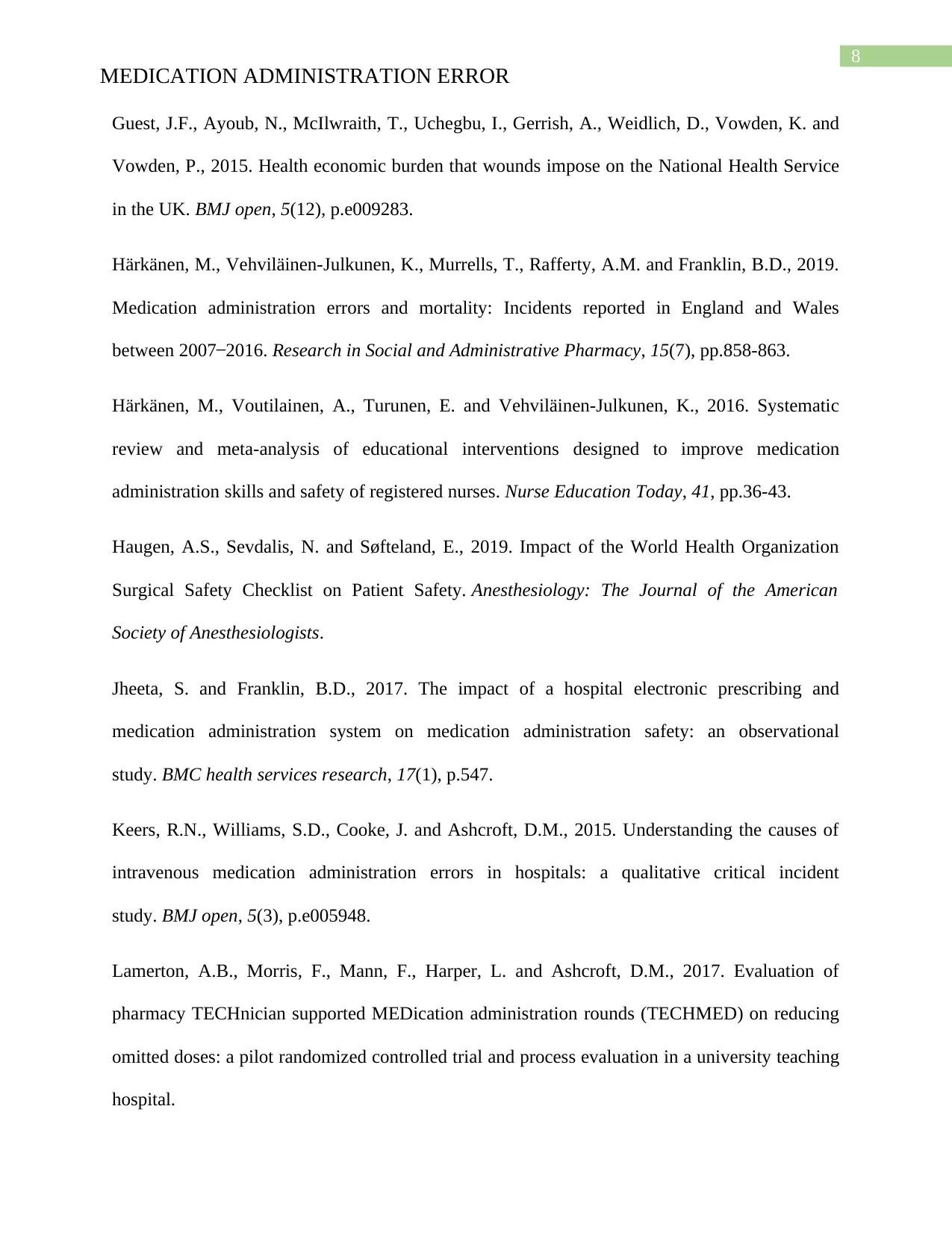
8
MEDICATION ADMINISTRATION ERROR
Guest, J.F., Ayoub, N., McIlwraith, T., Uchegbu, I., Gerrish, A., Weidlich, D., Vowden, K. and
Vowden, P., 2015. Health economic burden that wounds impose on the National Health Service
in the UK. BMJ open, 5(12), p.e009283.
Härkänen, M., Vehviläinen-Julkunen, K., Murrells, T., Rafferty, A.M. and Franklin, B.D., 2019.
Medication administration errors and mortality: Incidents reported in England and Wales
between 2007 ̶ 2016. Research in Social and Administrative Pharmacy, 15(7), pp.858-863.
Härkänen, M., Voutilainen, A., Turunen, E. and Vehviläinen-Julkunen, K., 2016. Systematic
review and meta-analysis of educational interventions designed to improve medication
administration skills and safety of registered nurses. Nurse Education Today, 41, pp.36-43.
Haugen, A.S., Sevdalis, N. and Søfteland, E., 2019. Impact of the World Health Organization
Surgical Safety Checklist on Patient Safety. Anesthesiology: The Journal of the American
Society of Anesthesiologists.
Jheeta, S. and Franklin, B.D., 2017. The impact of a hospital electronic prescribing and
medication administration system on medication administration safety: an observational
study. BMC health services research, 17(1), p.547.
Keers, R.N., Williams, S.D., Cooke, J. and Ashcroft, D.M., 2015. Understanding the causes of
intravenous medication administration errors in hospitals: a qualitative critical incident
study. BMJ open, 5(3), p.e005948.
Lamerton, A.B., Morris, F., Mann, F., Harper, L. and Ashcroft, D.M., 2017. Evaluation of
pharmacy TECHnician supported MEDication administration rounds (TECHMED) on reducing
omitted doses: a pilot randomized controlled trial and process evaluation in a university teaching
hospital.
MEDICATION ADMINISTRATION ERROR
Guest, J.F., Ayoub, N., McIlwraith, T., Uchegbu, I., Gerrish, A., Weidlich, D., Vowden, K. and
Vowden, P., 2015. Health economic burden that wounds impose on the National Health Service
in the UK. BMJ open, 5(12), p.e009283.
Härkänen, M., Vehviläinen-Julkunen, K., Murrells, T., Rafferty, A.M. and Franklin, B.D., 2019.
Medication administration errors and mortality: Incidents reported in England and Wales
between 2007 ̶ 2016. Research in Social and Administrative Pharmacy, 15(7), pp.858-863.
Härkänen, M., Voutilainen, A., Turunen, E. and Vehviläinen-Julkunen, K., 2016. Systematic
review and meta-analysis of educational interventions designed to improve medication
administration skills and safety of registered nurses. Nurse Education Today, 41, pp.36-43.
Haugen, A.S., Sevdalis, N. and Søfteland, E., 2019. Impact of the World Health Organization
Surgical Safety Checklist on Patient Safety. Anesthesiology: The Journal of the American
Society of Anesthesiologists.
Jheeta, S. and Franklin, B.D., 2017. The impact of a hospital electronic prescribing and
medication administration system on medication administration safety: an observational
study. BMC health services research, 17(1), p.547.
Keers, R.N., Williams, S.D., Cooke, J. and Ashcroft, D.M., 2015. Understanding the causes of
intravenous medication administration errors in hospitals: a qualitative critical incident
study. BMJ open, 5(3), p.e005948.
Lamerton, A.B., Morris, F., Mann, F., Harper, L. and Ashcroft, D.M., 2017. Evaluation of
pharmacy TECHnician supported MEDication administration rounds (TECHMED) on reducing
omitted doses: a pilot randomized controlled trial and process evaluation in a university teaching
hospital.
⊘ This is a preview!⊘
Do you want full access?
Subscribe today to unlock all pages.

Trusted by 1+ million students worldwide
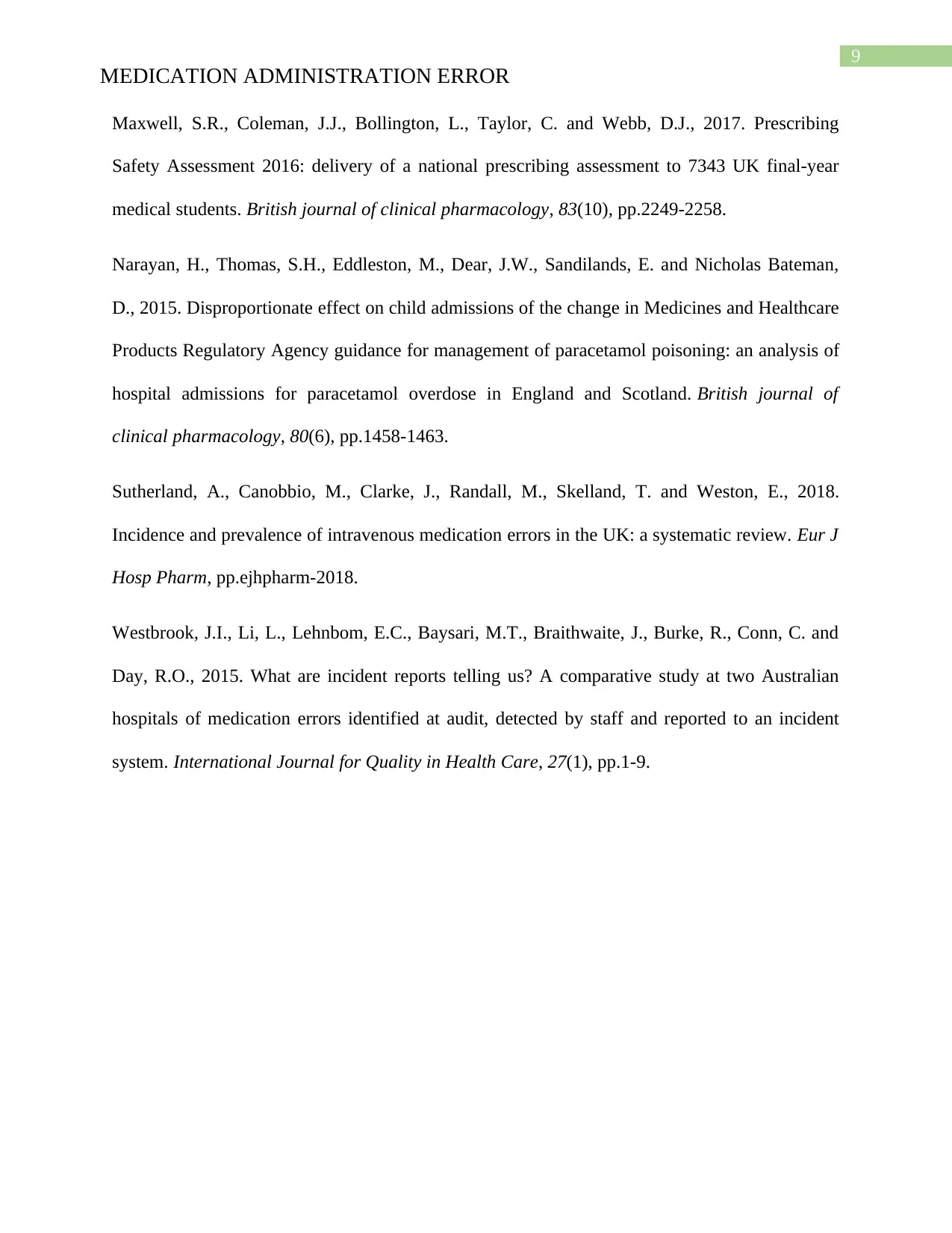
9
MEDICATION ADMINISTRATION ERROR
Maxwell, S.R., Coleman, J.J., Bollington, L., Taylor, C. and Webb, D.J., 2017. Prescribing
Safety Assessment 2016: delivery of a national prescribing assessment to 7343 UK final‐year
medical students. British journal of clinical pharmacology, 83(10), pp.2249-2258.
Narayan, H., Thomas, S.H., Eddleston, M., Dear, J.W., Sandilands, E. and Nicholas Bateman,
D., 2015. Disproportionate effect on child admissions of the change in Medicines and Healthcare
Products Regulatory Agency guidance for management of paracetamol poisoning: an analysis of
hospital admissions for paracetamol overdose in England and Scotland. British journal of
clinical pharmacology, 80(6), pp.1458-1463.
Sutherland, A., Canobbio, M., Clarke, J., Randall, M., Skelland, T. and Weston, E., 2018.
Incidence and prevalence of intravenous medication errors in the UK: a systematic review. Eur J
Hosp Pharm, pp.ejhpharm-2018.
Westbrook, J.I., Li, L., Lehnbom, E.C., Baysari, M.T., Braithwaite, J., Burke, R., Conn, C. and
Day, R.O., 2015. What are incident reports telling us? A comparative study at two Australian
hospitals of medication errors identified at audit, detected by staff and reported to an incident
system. International Journal for Quality in Health Care, 27(1), pp.1-9.
MEDICATION ADMINISTRATION ERROR
Maxwell, S.R., Coleman, J.J., Bollington, L., Taylor, C. and Webb, D.J., 2017. Prescribing
Safety Assessment 2016: delivery of a national prescribing assessment to 7343 UK final‐year
medical students. British journal of clinical pharmacology, 83(10), pp.2249-2258.
Narayan, H., Thomas, S.H., Eddleston, M., Dear, J.W., Sandilands, E. and Nicholas Bateman,
D., 2015. Disproportionate effect on child admissions of the change in Medicines and Healthcare
Products Regulatory Agency guidance for management of paracetamol poisoning: an analysis of
hospital admissions for paracetamol overdose in England and Scotland. British journal of
clinical pharmacology, 80(6), pp.1458-1463.
Sutherland, A., Canobbio, M., Clarke, J., Randall, M., Skelland, T. and Weston, E., 2018.
Incidence and prevalence of intravenous medication errors in the UK: a systematic review. Eur J
Hosp Pharm, pp.ejhpharm-2018.
Westbrook, J.I., Li, L., Lehnbom, E.C., Baysari, M.T., Braithwaite, J., Burke, R., Conn, C. and
Day, R.O., 2015. What are incident reports telling us? A comparative study at two Australian
hospitals of medication errors identified at audit, detected by staff and reported to an incident
system. International Journal for Quality in Health Care, 27(1), pp.1-9.
1 out of 10
Related Documents
Your All-in-One AI-Powered Toolkit for Academic Success.
+13062052269
info@desklib.com
Available 24*7 on WhatsApp / Email
![[object Object]](/_next/static/media/star-bottom.7253800d.svg)
Unlock your academic potential
Copyright © 2020–2025 A2Z Services. All Rights Reserved. Developed and managed by ZUCOL.




